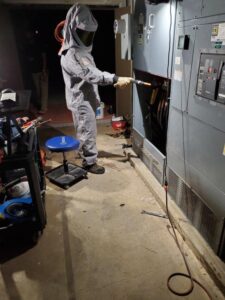Ask ten people what starts an arcflash and you’ll hear everything from “it only happens above 600 V” to “PPE fixes the problem.” After twenty odd years crawling through switchrooms, I’ve learned that most of those answers are—well—half right at best. Let’s unpack the five myths you might run into the most and the engineering facts that push back on those myths.
Myth 1 “Arc flash is a medium/highvoltage problem.”
Reality: At 208 V, an 80kA fault cleared in 0.20 s still dumps around 10 cal/cm² on the worker’s chest—well above Category 2 limits. Voltage is just one variable; arcing current, clearing time, gap, and working distance call the shots. IEEE 15842018 updated the arcing current equations precisely because low voltage systems were underpredicted in the 2002 model.
Myth 2 “Brand new gear is practically arcflash proof.”
Reality: New metal doesn’t stay new once it’s wired, leaned on, and neglected. A swapped feeder breaker or a larger utility transformer can double the available fault current overnight. NFPA 70E2024 even added an informational note listing system changes—including transformer sizing—that invalidate your last study (Article 130.5(G) note).
Myth 3 “If the breaker’s trip curve looks fast, I’m safe.”
Reality: A time–current curve shows how a device reacts to bolted fault current. The arcing current is lower—sometimes low enough to ride the breaker’s longtime band and burn for 30 + cycles. IEEE 1584 calls for calculating two arcing current values (100% and 85%) and rerunning the protective device model for each. Skip that step and you’re guessing.
Myth 4 “Dust and corrosion aren’t a big deal.”
Reality: A dusty MCC is basically a resistor network waiting to conduct. Surface contamination lowers breakdown voltage, letting an arc jump at normal operating voltage that would otherwise be harmless. NFPA 70E places equipment condition right next to design when assessing likelihood of an event (Table 130.5(C)).
Myth 5 “PPE is the main line of defense.”
Reality: PPE is the last line. Table 130.5(G) in NFPA 70E2024 literally appears after the risk assessment steps that ask whether you can engineer the energy down first. If your incident energy is 40 cal/cm² and you simply issue a Category 4 suit, you’ve accepted a fire suit budget and the downtime that comes with it. There’s usually a smarter fix: current limiting fuses, maintenance settings, relay setting audits, remote racking, or just cleaning the gear.
Why this isn’t just academic
- Human cost Arc temperatures reach 35,000 °F; survivability drops to near zero above 12 cal/cm².
- Operational cost OSHA fines, lost production, litigation—one event can blow past $1 M in
- Compliance Labels must now survive the environment they live in (70E 5(H)), and studies must be updated when “system modifications” occur. Staying current isn’t optional.
If your last arcflash label predates the 2018 IEEE model—or if you’ve added a single piece of gear since then—your numbers might be wishful. And no, a fresh set of gloves won’t fix it.
Got questions? Drop them below or DM us. We’d be happy to discuss your facility and the risks involved in delaying your facility arc flash hazard analysis.
Arc Flash PPE Reference Guide:
Fill out the form below to download our FREE Arc Flash PPE Reference Guide!


